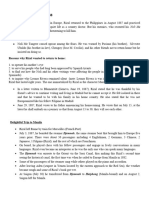0 ratings0% found this document useful (0 votes)
413 viewsJuan Sitges Was A Successor of CPT
Juan Sitges Was A Successor of CPT
Uploaded by
Kristine PacalJuan Sitges became the new political-military captain in Dapitan, replacing Ricardo Carnicero. As a physician, Sitges should have had a friendly relationship with Jose Rizal, who was also a medical student. However, their relationship was distant, likely due to instructions Sitges received regarding Rizal's imprisonment or because of Carnicero's intimacy with Rizal which led to his removal. Sitges imposed security measures on Rizal and had him report frequently to headquarters, requiring Rizal to live in a nearby house rather than at the captain's residence.
Copyright:
© All Rights Reserved
Available Formats
Download as DOCX, PDF, TXT or read online from Scribd
Juan Sitges Was A Successor of CPT
Juan Sitges Was A Successor of CPT
Uploaded by
Kristine Pacal0 ratings0% found this document useful (0 votes)
413 views1 pageJuan Sitges became the new political-military captain in Dapitan, replacing Ricardo Carnicero. As a physician, Sitges should have had a friendly relationship with Jose Rizal, who was also a medical student. However, their relationship was distant, likely due to instructions Sitges received regarding Rizal's imprisonment or because of Carnicero's intimacy with Rizal which led to his removal. Sitges imposed security measures on Rizal and had him report frequently to headquarters, requiring Rizal to live in a nearby house rather than at the captain's residence.
Original Title
Juan Sitges was a successor of Cpt
Copyright
© © All Rights Reserved
Available Formats
DOCX, PDF, TXT or read online from Scribd
Share this document
Did you find this document useful?
Is this content inappropriate?
Juan Sitges became the new political-military captain in Dapitan, replacing Ricardo Carnicero. As a physician, Sitges should have had a friendly relationship with Jose Rizal, who was also a medical student. However, their relationship was distant, likely due to instructions Sitges received regarding Rizal's imprisonment or because of Carnicero's intimacy with Rizal which led to his removal. Sitges imposed security measures on Rizal and had him report frequently to headquarters, requiring Rizal to live in a nearby house rather than at the captain's residence.
Copyright:
© All Rights Reserved
Available Formats
Download as DOCX, PDF, TXT or read online from Scribd
Download as docx, pdf, or txt
0 ratings0% found this document useful (0 votes)
413 views1 pageJuan Sitges Was A Successor of CPT
Juan Sitges Was A Successor of CPT
Uploaded by
Kristine PacalJuan Sitges became the new political-military captain in Dapitan, replacing Ricardo Carnicero. As a physician, Sitges should have had a friendly relationship with Jose Rizal, who was also a medical student. However, their relationship was distant, likely due to instructions Sitges received regarding Rizal's imprisonment or because of Carnicero's intimacy with Rizal which led to his removal. Sitges imposed security measures on Rizal and had him report frequently to headquarters, requiring Rizal to live in a nearby house rather than at the captain's residence.
Copyright:
© All Rights Reserved
Available Formats
Download as DOCX, PDF, TXT or read online from Scribd
Download as docx, pdf, or txt
You are on page 1of 1
Juan Sitges was a successor of Cpt.
Ricardo Carnicero, he was the new
Politico military captain. He was also a physician but in spite of this
common circumstances, which should have led to fellowship between him and
rizal because they both studied in medical field, their relationship was
distant either because of instructions he received or because he had
learned that Carnicero was removed precisely because of his intimacy with
Rizal. Rizal stopped taking his meals at the captain’s house as he used
to do. He had to report frequently at headquarters and so had to live in
a nearby house. These and other security measures were adopted by Sitges.
In his report to Ochando, Sitges said that he seemed to like rizal in
spite of the distance he set. This is another proof of the naturally
pleasing personality of our hero.
As time passed, Sitges became more liberal with the prisoner. He took over
care of Jose Rizal and also gave him favorable reports regarding his
behavior in Dapitan.
During the early part of his exile in Dapitan, Rizal lived at the
commandant’s residence. With his prize from the Manila Lottery and his
earnings as a farmer and a merchant, he bought a piece of land near the
shore of Talisay near Dapitan. On this land, he built three houses- all
made of bamboo, wood, and nipa. The first house which was square in shape
was his home, Jose lived with his sisters and mother in the square house.
The second house was the living quarters of his pupils. Rizal established a
school in Dapitan. It began with 3 pupils then increased to 21. Formal
classes were between 2:00 pm to 4:00 pm. He also applied the “emperor”
system like that of Ateneo. He made a poem “Hymn to Talisay”, in honor of
Talisay which he made his pupils sing. And the third house was the barn
where he kept his chickens.
Rizal's life went on as before: teaching his boys as he called them,
attending to the sick, treating fractures with rattan and bamboo, and
gradually falling into a state of depression. What is surprising is that he
did not have a nervous breakdown.
Rizal's daily life continued without change. The only novelty being his
project of constructing a water dike and reservoir. He was helped by 14
boys who, in exchange for gratuitous help from Rizal, worked for him. He
also put up a water conveyor system out of the primitive materials
available then: bamboo, bricks, and mortar, this conducted the water to a
fountain with a lion’s head of clay molded by Rizal himself.
The last days of February 1893, three passengers arrived; one of whom would
change the monotonous fife of Rizal in Dapitan. The hewcomers were George
Taufer; Josephine Bracken, his adopted daughter; and Manuela Orlac,
F i l i p i n a c o m p a n i o n w h o accompanied Josephine Bracken to Dapitan. And a
friend of a churchman from the Cathedral of Manila. Taufer presented
himself with a letter of introduction from Julio Llorente who recommended
Rizal to treat him.
Taufer became blind so he sought for an ophthalmic specialist. he
was about 65 years old, and his last 25 years were spent in Hong Kong.
worked as an engineer in charge of the steam-powered fire engine run by
the Hong Kong Fire Insurance Company.During his first year in Hong Kong,
he had a daughter by a Chinese woman, named, Sara. Two years later, Taufer
married a Portuguese woman from Macao unfortunately they did not bear a
child.
According to Coates, for Taufer was a syphilitic (a bacterial infection
spread by sexual contact) . Six years after his marriage in 1876, the
married English solider impregnate the Chinese woman and Taufer adopted
their daughter. when his wife died, he registered his illegitimate child,
Josephine Bracken, as the legitimate daughter of his recently deceased
wife.
You might also like
- Maximo ViolaDocument2 pagesMaximo ViolaJan-jan Avila SadsmileyNo ratings yet
- Week 5 BDocument10 pagesWeek 5 BVencint LaranNo ratings yet
- Relevance of Noli Me Tangere To The Youth ActivismDocument21 pagesRelevance of Noli Me Tangere To The Youth ActivismJag MasterNo ratings yet
- Purposive Communication OverviewDocument4 pagesPurposive Communication OverviewLineClar RealNo ratings yet
- Rizal's Grand Tour of Europe With Viola (1887)Document18 pagesRizal's Grand Tour of Europe With Viola (1887)Laong laanNo ratings yet
- Unit IV - Education and Travel Abroad: 1. Universidad Central de Madrid 2. Rizal As MasonDocument2 pagesUnit IV - Education and Travel Abroad: 1. Universidad Central de Madrid 2. Rizal As MasonAlmineNo ratings yet
- Teodora Alonzo Was A Woman of Steel: So That's Where Jose Rizal Got His FireDocument13 pagesTeodora Alonzo Was A Woman of Steel: So That's Where Jose Rizal Got His FireAJ Grean EscobidoNo ratings yet
- Group 2women Linked To Rizal and Rizal Winning The LottoDocument15 pagesGroup 2women Linked To Rizal and Rizal Winning The Lottoleny100% (1)
- Art Appreciation: Ms. Glaidel C. Dela Cruz, LPTDocument25 pagesArt Appreciation: Ms. Glaidel C. Dela Cruz, LPTmysterioushumane100% (1)
- Chapter 10 - First HomecomingDocument6 pagesChapter 10 - First HomecomingGerald Tan EullaranNo ratings yet
- Brief Historical Background of Science and Technology in The PhilippinesDocument4 pagesBrief Historical Background of Science and Technology in The PhilippinesEstrella Marie BungabongNo ratings yet
- College of Arts and Sciences: PretestDocument5 pagesCollege of Arts and Sciences: PretestLeizel CervantesNo ratings yet
- CRPH Chapter 2 ActivitesDocument5 pagesCRPH Chapter 2 ActivitesEj Ferrer100% (1)
- The Avid Collector of RizalDocument1 pageThe Avid Collector of RizalSophia Catalan0% (1)
- GATO-Reflection On The Readings in Philippine HistoryDocument2 pagesGATO-Reflection On The Readings in Philippine HistoryIsnihaya GatoNo ratings yet
- Chapter 1Document8 pagesChapter 1Jessie Jade DurojaNo ratings yet
- Rizal Chapter2Document23 pagesRizal Chapter2Potchie MendozaNo ratings yet
- Lesson Plan Template 1Document7 pagesLesson Plan Template 1Cyrylle Doyayag MagloyuanNo ratings yet
- CrueltyDocument20 pagesCrueltyItpixels OfficebackdoorNo ratings yet
- Chapter 5 RizalDocument10 pagesChapter 5 RizalRochelle Ann Balolong DianeNo ratings yet
- Group 1 Written ReportDocument13 pagesGroup 1 Written ReportIvy LastaNo ratings yet
- Why Do We Need To Study RizalDocument22 pagesWhy Do We Need To Study RizalHera leyNo ratings yet
- Little BadBOy Rizal Sa EsapanyaDocument2 pagesLittle BadBOy Rizal Sa EsapanyaMary Grace PeritoNo ratings yet
- Assignment 1 (GE 2)Document3 pagesAssignment 1 (GE 2)Hazel TejanaNo ratings yet
- Gavino TronioDocument2 pagesGavino TroniojasslyneNo ratings yet
- Chapter 9 Rizal CDocument31 pagesChapter 9 Rizal Cbatsteed100% (3)
- Tree Planting ReflectionDocument1 pageTree Planting ReflectionAngilyn LagaticNo ratings yet
- 567 ArtDocument6 pages567 ArtRJ DAVE DURUHANo ratings yet
- Lesson 4 - Rizal's Life As A StudentDocument11 pagesLesson 4 - Rizal's Life As A StudentCrl MiNo ratings yet
- Power Point About Jose Rizal in Expressed of His AdvocacyDocument20 pagesPower Point About Jose Rizal in Expressed of His AdvocacyKJ Marquez100% (2)
- The Komisyon Sa Wikang Filipino Was The First To Issue A Statement Endorsing MotherDocument9 pagesThe Komisyon Sa Wikang Filipino Was The First To Issue A Statement Endorsing MotherSarah BaylonNo ratings yet
- Rizal's Life: at The End of The Lesson, The Student Should Be Able ToDocument7 pagesRizal's Life: at The End of The Lesson, The Student Should Be Able ToElla Paulette WenceslaoNo ratings yet
- Philippine NationalismDocument1 pagePhilippine NationalismromerosomichaeljohnbsitNo ratings yet
- Chapter 10 Life of Jose RizalDocument24 pagesChapter 10 Life of Jose RizalCamille Arocena DoradoNo ratings yet
- The TeacherDocument71 pagesThe TeacherMicheleNo ratings yet
- "Political Caricature of The American Era": Figure 1. Cartoon Published in The Independent On May 20 1916Document3 pages"Political Caricature of The American Era": Figure 1. Cartoon Published in The Independent On May 20 1916Florian M. GutierrezNo ratings yet
- Chapter 19 GarciaDocument10 pagesChapter 19 GarciaLunar WalkerNo ratings yet
- Agreement or Disagreement Sugar ConsumptionDocument21 pagesAgreement or Disagreement Sugar ConsumptionBermel BerkonNo ratings yet
- Chapter 14 Rizal in LondonDocument30 pagesChapter 14 Rizal in LondonFlehzy EstollosoNo ratings yet
- Rizal in LondonDocument32 pagesRizal in LondonMy HomeNo ratings yet
- GE9 February 26, 2023 Rizal's Grand Tour With Viola 1887 Quiz QuestionsDocument1 pageGE9 February 26, 2023 Rizal's Grand Tour With Viola 1887 Quiz QuestionsEmmanuel SindolNo ratings yet
- The Scope of HumanitiesDocument2 pagesThe Scope of HumanitiesMara Jinky Balerio AlmironNo ratings yet
- Ophthalmic Surgeon in HKDocument4 pagesOphthalmic Surgeon in HKJOHAYNIENo ratings yet
- Rizal and The Development of National ConciousnessDocument87 pagesRizal and The Development of National ConciousnessEd Joseph RectoNo ratings yet
- Module 1 Introduction To STS Science Technology and SocietypdfDocument14 pagesModule 1 Introduction To STS Science Technology and SocietypdfOwenNo ratings yet
- Activity 1 in STSDocument5 pagesActivity 1 in STSOmar Aculan100% (1)
- Chapter 2 Lesson 2 Programs and Personalities in Science and Technology in The Phil.Document19 pagesChapter 2 Lesson 2 Programs and Personalities in Science and Technology in The Phil.alissonjaytabierosNo ratings yet
- Early FilipinoDocument32 pagesEarly FilipinoJeannie DesturaNo ratings yet
- Chapter 8Document5 pagesChapter 8Art Vincent Aguilar100% (1)
- Partido State University: G3-Contemporary WorldDocument7 pagesPartido State University: G3-Contemporary WorldEmmanuel GarciaNo ratings yet
- Filipino NationalismDocument23 pagesFilipino NationalismKareena GrasyaNo ratings yet
- Lesson Number: Lesson 11 (Week 12) Topic: Noli Me Tangere (Summary)Document8 pagesLesson Number: Lesson 11 (Week 12) Topic: Noli Me Tangere (Summary)Mariel C. SegadorNo ratings yet
- Week 7 RizalDocument6 pagesWeek 7 RizalShervee PabalateNo ratings yet
- Chapter 20Document3 pagesChapter 20Danica LachicaNo ratings yet
- Ge8 Art AppreDocument23 pagesGe8 Art Appregerald conejarNo ratings yet
- Rizal Activity 3Document1 pageRizal Activity 3Ron Angelo AciertoNo ratings yet
- Rizals First Time To Travel AbroadDocument29 pagesRizals First Time To Travel AbroadJohn Naley FabrosNo ratings yet
- Chapter 5 Rizal S Exile and DeathDocument21 pagesChapter 5 Rizal S Exile and DeathJASPER PETORIONo ratings yet
- A Brief History of Badminton from 1870 to 1949From EverandA Brief History of Badminton from 1870 to 1949Rating: 3.5 out of 5 stars3.5/5 (2)
- RIZAL PrintDocument9 pagesRIZAL PrintCristel CaraigNo ratings yet
- Compared To The Accounting For Business EntitiesDocument26 pagesCompared To The Accounting For Business EntitiesKristine PacalNo ratings yet
- Acctg 22 International Business and Trade - ReportingDocument3 pagesAcctg 22 International Business and Trade - ReportingKristine PacalNo ratings yet
- RizalDocument6 pagesRizalKristine PacalNo ratings yet
- Ihawig PenalDocument2 pagesIhawig PenalKristine PacalNo ratings yet
- Chapter 8 Trade and Investment PoliciesDocument3 pagesChapter 8 Trade and Investment PoliciesKristine PacalNo ratings yet
- The Period of Enlightenment (1872-1898) : Presented by Group 3Document81 pagesThe Period of Enlightenment (1872-1898) : Presented by Group 3Lab2x Sala100% (1)
- Activity 1.8Document2 pagesActivity 1.8Amaris SoleilNo ratings yet
- José Rizal and The Propaganda MovementDocument7 pagesJosé Rizal and The Propaganda MovementMarlo CardinezNo ratings yet
- Activity 1: The Setting I.: 1. Is The Novel Set in A Particular Time Period?Document5 pagesActivity 1: The Setting I.: 1. Is The Novel Set in A Particular Time Period?Maria Cristina ImportanteNo ratings yet
- Week3 Rizal's National ConsciousnessDocument38 pagesWeek3 Rizal's National ConsciousnessChelmarieNo ratings yet
- Movie Review. RizalDocument4 pagesMovie Review. RizalJoyce AgnerNo ratings yet
- Rizal ReviewerDocument6 pagesRizal ReviewerKristara MendozaNo ratings yet
- Rizals Arrest Exile Imprisonment TrialDocument35 pagesRizals Arrest Exile Imprisonment TrialCarldave Pareja25% (4)
- Life and Works of Rizal Midterm ReviewerDocument7 pagesLife and Works of Rizal Midterm ReviewerMargaret Joy SobredillaNo ratings yet
- MODULE 4-Rizal's Higher Education and Life AbroadDocument3 pagesMODULE 4-Rizal's Higher Education and Life AbroadJayvee BustardeNo ratings yet
- Document Rizal - 012038Document5 pagesDocument Rizal - 012038John Michael LesacaNo ratings yet
- Behavioral Verbs For Effective Learning Objectives 2012Document37 pagesBehavioral Verbs For Effective Learning Objectives 2012mikaNo ratings yet
- Bs - Psych Arts AppreciationDocument3 pagesBs - Psych Arts Appreciationyanice coleen diazNo ratings yet
- BlogDocument2 pagesBlogAngie CadornaNo ratings yet
- Intra Clergy Conflict and Creole NationalismDocument2 pagesIntra Clergy Conflict and Creole NationalismKeena SalinasNo ratings yet
- RizalDocument16 pagesRizalPatricia Nicole BolivarNo ratings yet
- Rizal in EuropeDocument28 pagesRizal in EuropeAndrone Ursais100% (1)
- Family, Childhood, and Early Education: Rizal's LifeDocument21 pagesFamily, Childhood, and Early Education: Rizal's LifeCrusty GirlNo ratings yet
- This Study Resource WasDocument4 pagesThis Study Resource WasMae KanawutNo ratings yet
- Rizal in Europe: The Beginning of The Propaganda MovementDocument16 pagesRizal in Europe: The Beginning of The Propaganda MovementHaidei Maliwanag Panopio0% (1)
- For Rizal To Be A Role Model For The Youth of His Country.Document7 pagesFor Rizal To Be A Role Model For The Youth of His Country.Marc Josua De JesusNo ratings yet
- Enhancement of Assessment Tools in Filipino and Edukasyon Sa Pagpapakatao Narrative ReportDocument3 pagesEnhancement of Assessment Tools in Filipino and Edukasyon Sa Pagpapakatao Narrative ReportMaria RodriguezNo ratings yet
- A Survey of Philippine Literature - Cristobal ZarcoDocument3 pagesA Survey of Philippine Literature - Cristobal ZarcohIgh QuaLIty SVT100% (1)
- Last Hours of RizalDocument3 pagesLast Hours of RizalXiamara SophieNo ratings yet
- 12 Defenses and RetractionDocument18 pages12 Defenses and RetractionpotatosaysNo ratings yet
- Research Paper Jose RizalDocument7 pagesResearch Paper Jose Rizalafnkceovfqcvwp100% (1)
- Supplemenary Notes - Rizal's Acounts of The 19th CenturyDocument7 pagesSupplemenary Notes - Rizal's Acounts of The 19th CenturyJanperson WacnagNo ratings yet
- Rizal Specialization in Medicine and Other AchievementsDocument13 pagesRizal Specialization in Medicine and Other AchievementsRachelle Daling100% (4)
- RizalDocument14 pagesRizalMhariah My-an ManriqueNo ratings yet






























































































